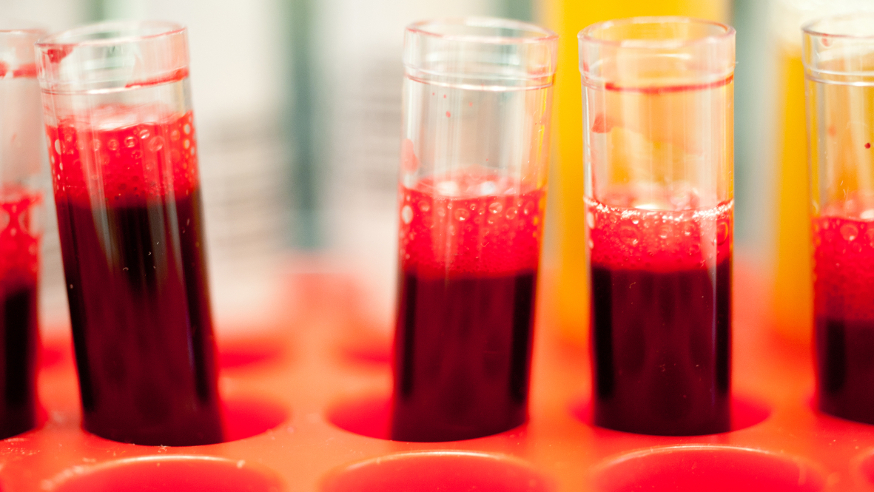
Image: Blood samples in tubes
A liquid biopsy is a new type of blood test, where a scientist or clinician takes a sample from a patient before, during and after a course of cancer treatment.
The tests assess tumour cells or DNA in the bloodstream, and represent a major step forward in our ability to monitor a cancer and how it responds to treatment.
Previously, the only way to get detailed genetic information about tumours was to take a tissue biopsy either during surgery or through use of a needle – and because that’s uncomfortable for patients, there is a limit to how many times it can be done.
A fascinating session at the National Cancer Research Institute (NCRI) conference gave an overview of how researchers are starting to use liquid biopsies to monitor patients and guide clinical decisions.
Monitoring cancer progression
Dr Nitzan Rosenfeld of the Cancer Research UK Cambridge Institute introduced these tests with particular reference to his own work in lung cancer.
He pointed to examples where blood tests could be used to identify cancer mutations, allowing researchers to tell when relapse is occurring from very early on. Some of this research was conducted with the chair of the session Professor Nicholas Turner here at The Institute of Cancer Research.
Professor Johann de Bono, Regius Professor of Cancer Research at the ICR, gave a fascinating talk about the importance of these tests in understanding the progression of a cancer in response to treatment.
His talk discussed tests for both circulating tumour cells (CTCs) and cancer DNA shed into the bloodstream, and how these could be used in the treatment of prostate cancer.
His argument was that these could act as a biomarker – a biological measure – to indicate whether treatment was working and how a cancer was responding.
Catch up with all the latest ICR blog posts and video content from the 2018 National Cancer Research Institute (NCRI) conference 2018 in Glasgow.
Read more
Extracting circulating tumour cells
CTCs are cancer cells that travel around the bloodstream, sowing the seeds for metastatic cancers to develop. A liquid biopsy, being a blood test, is ideally placed to detect them.
Using a technique called diagnostic apheresis, doctors can pass a patient's blood through a machine, removing circulating tumour cells before returning the blood to the patient's body.
This procedure takes two hours, and is tolerated well, with no adverse effects.
As well as removing harmful CTCs, this technique also allows researchers to study those that have been collected in order to better understand how their patient's cancer is developing.
Testing these cells can allow for more personalised medicine because they allow clinical decisions to be made on the basis of how many cells are there and what genetic changes are detected.
DNA in the bloodstream
As well as detecting circulating cells, liquid biopsies can also analyse DNA shed by a tumour into the bloodstream. This gives a quick way of assessing what DNA mutations may be present in the cancer – and this information can then be used in the selection of treatments.
For example, recent research by Professor de Bono and colleagues has suggested that picking up certain genetic defects in DNA repair genes within tumours can help select patients who might be particularly likely to respond to immunotherapy.
The final talk in the session was given by Professor Thomas Wurdinger of the VU University Medical Centre Amsterdam, who presented results showing that men with prostate cancer who will respond to the drug nivolumab can be identified through a blood test.
This could lead to a 50 per cent reduction in the number of patients who have to experience difficult and unnecessary side-effects from such treatment without gaining any benefit from it.
The message from the session was exciting – that liquid biopsies are not only giving us new insight into how cancer develops, but are already starting to improve treatment for patients by guiding clinical decisions.
To keep updated on the conference, follow @ICR_London and #NCRI2018 on Twitter for all the latest.
comments powered by